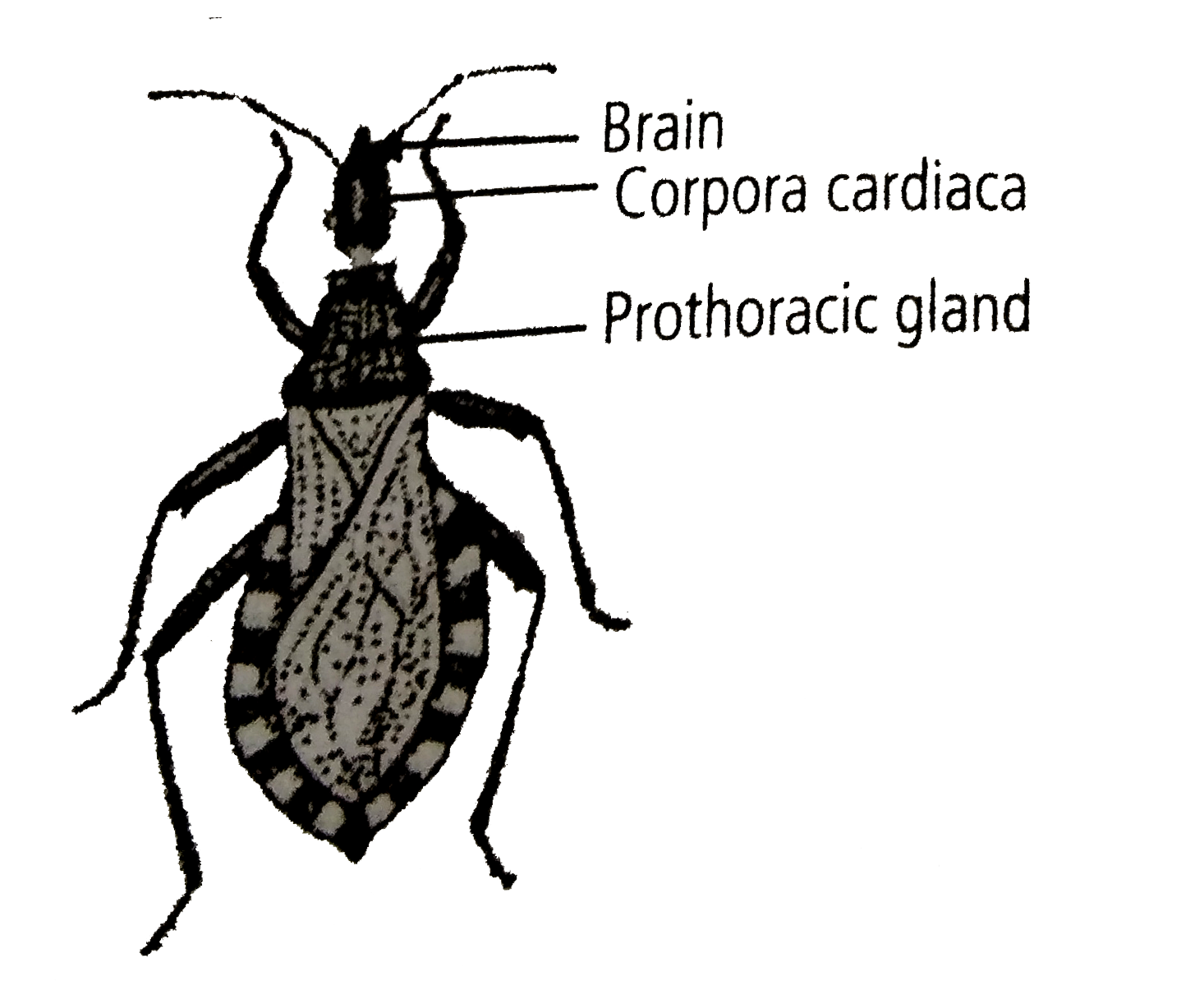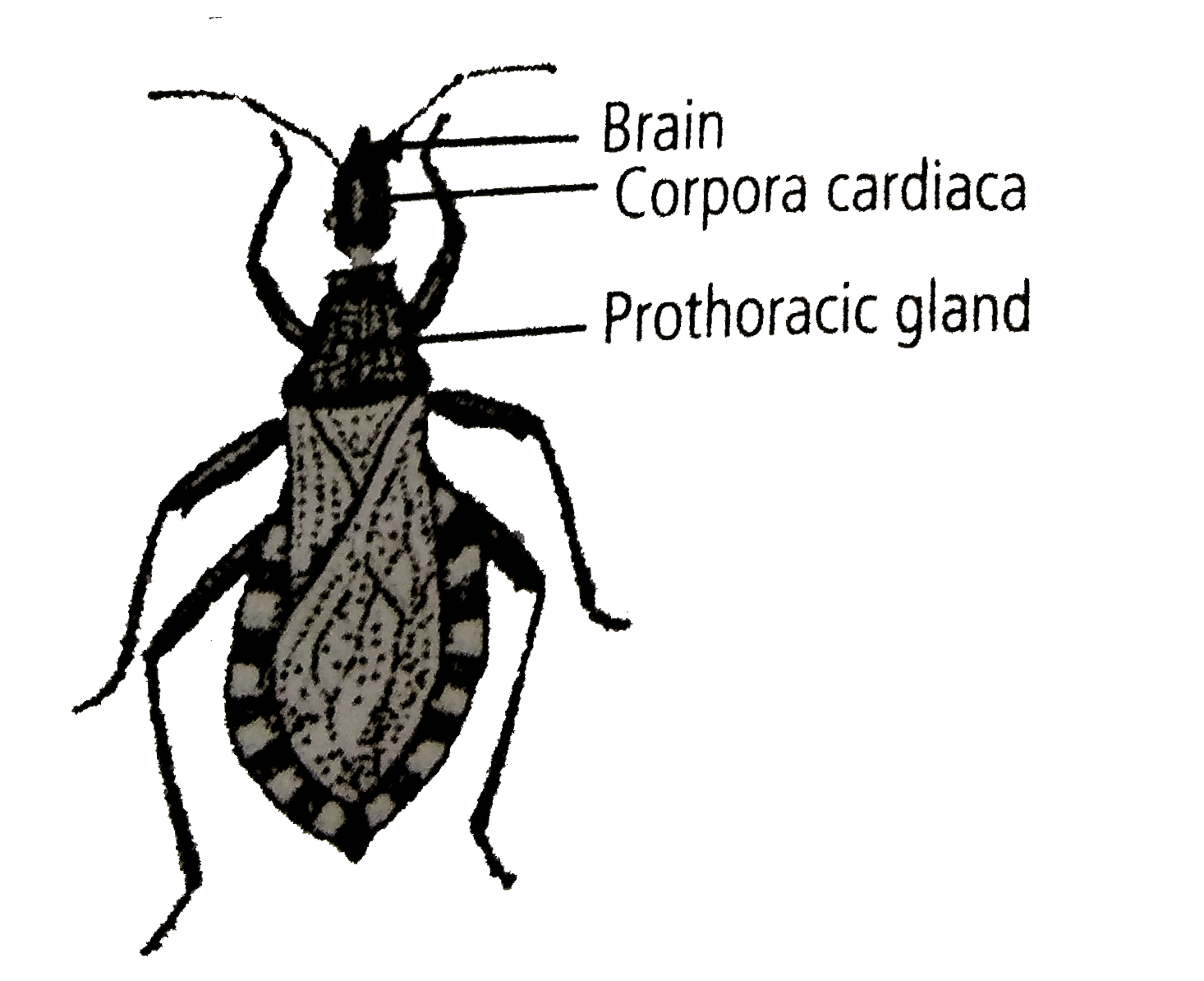Read the given passage and answer the questions that follows: Rhodinus, a blood-sucking bug, shows five instars before it metamorphoses into an adult. It ahs a very long head with the brain located at tip and an organ called Corpora Cardiaca (C C) behind it. The hormone that ensures the continuum of the juvenile stages is called a juvenile hormone. Behind the head is a pro - thoracic gland, which gets triggered by the Pro - Thoracico - Tropic Hormone (PTTH) to release ecdysone required for molting into an adult.

The following observations were made when the juveniles of this insect were subjected to various conditions :
1. Starved juveniles (any instar) when decapitated → remained juveniles and did not molt into adults.
2. Well-fed juveniles (any instar) when decapitated → molted into adults.
3. Starved juveniles (any instar) when partially decapitated to remove the brain cells → remained juveniles and did not molt into adults.
4. Well - fed juveniles (any instar) when partially deitated to remove the brain cells → did not molt into adults.
Which of the following conclusions can be drawn from this data ?
(i) Ecdysone hormone is produced irrespective of the level of feeding.
(ii) C C is the site of production of juvenile hormone.
(iii) PTTH is produced irrespective of the level of feeding.
(iv) Increase in juvenile hormone is an important trigger for production of PTTH.
(v) Absence of C C alone is a trigger for molting into adult form.
(vi) Well-fed larvae in absence of juvenile hotmone can molt into adults.
(i), (iii) (iv) and (v)
(ii), (iv) and (v)
(ii) and (vi)
(i) and (iv)
The correct Answer is:C
Step by step video, text & image solution for Read the given passage and answer the questions that follows: Rhodinus, a blood-sucking bug, shows five instars before it metamorphoses into an adult. It ahs a very long head with the brain located at tip and an organ called Corpora Cardiaca (C C) behind it. The hormone that ensures the continuum of the juvenile stages is called a juvenile hormone. Behind the head is a pro - thoracic gland, which gets triggered by the Pro - Thoracico - Tropic Hormone (PTTH) to release ecdysone required for molting into an adult. The following observations were made when the juveniles of this insect were subjected to various conditions : 1. Starved juveniles (any instar) when decapitated rarr remained juveniles and did not molt into adults. 2. Well-fed juveniles (any instar) when decapitated rarr molted into adults. 3. Starved juveniles (any instar) when partially decapitated to remove the brain cells rarr remained juveniles and did not molt into adults. 4. Well - fed juveniles (any instar) when partially deitated to remove the brain cells rarr did not molt into adults. Which of the following conclusions can be drawn from this data ? (i) Ecdysone hormone is produced irrespective of the level of feeding. (ii) C C is the site of production of juvenile hormone. (iii) PTTH is produced irrespective of the level of feeding. (iv) Increase in juvenile hormone is an important trigger for production of PTTH. (v) Absence of C C alone is a trigger for molting into adult form. (vi) Well-fed larvae in absence of juvenile hotmone can molt into adults. by Biology experts to help you in doubts & scoring excellent marks in Class 11 exams.
Updated on:21/07/2023Topper's Solved these Questions
Similar Questions
Knowledge Check
Read the given passage and answer the questions that follows: Rhodinus, a blood-sucking bug, shows five instars before it metamorphoses into an adult. It ahs a very long head with the brain located at tip and an organ called Corpora Cardiaca (C C) behind it. The hormone that ensures the continuum of the juvenile stages is called a juvenile hormone. Behind the head is a pro - thoracic gland, which gets triggered by the Pro - Thoracico - Tropic Hormone (PTTH) to release ecdysone required for molting into an adult.

The following observations were made when the juveniles of this insect were subjected to various conditions :
1. Starved juveniles (any instar) when decapitated → remained juveniles and did not molt into adults.
2. Well-fed juveniles (any instar) when decapitated → molted into adults.
3. Starved juveniles (any instar) when partially decapitated to remove the brain cells → remained juveniles and did not molt into adults.
4. Well - fed juveniles (any instar) when partially deitated to remove the brain cells → did not molt into adults.
If an unfed, completely decapitated, fth (final) instar juvenile is connected to a well-fed, decapitated fourth instar juvenile by a glass tube so that fluids can be exchanged, what whill be the expected result ?ABoth bugs will continue to remain juveniles.BBoth bugs will molt into adult forms.CThe bug in the fourth instar will remain as a juvenile while the one in the fifth instar will molt into an adult.DThe bug in the fourth instar will molt into an adult and the one in the fifth instar will remain as a juvenile.Which of the following is called as phytogerontogical hormone
AEhtyleneBAuxinCGibberellinDCytokininIn insects, the effect of juvenile hormone is to
APotentiate effect of ecdysoneBOppose the effect of ecdysoneCEffect maturationDPrevent maturation.
Which one of the following is called as milk ejection hormone and birth hormone ?
View SolutionJuvenile hormone causes
View SolutionEndocrine glands of insects which secrete juvenile hormone are
View SolutionThe endocrine gland of insect which secrete the juvenile hormone is
View SolutionJuvenile hormone in insects is released from
View Solution
